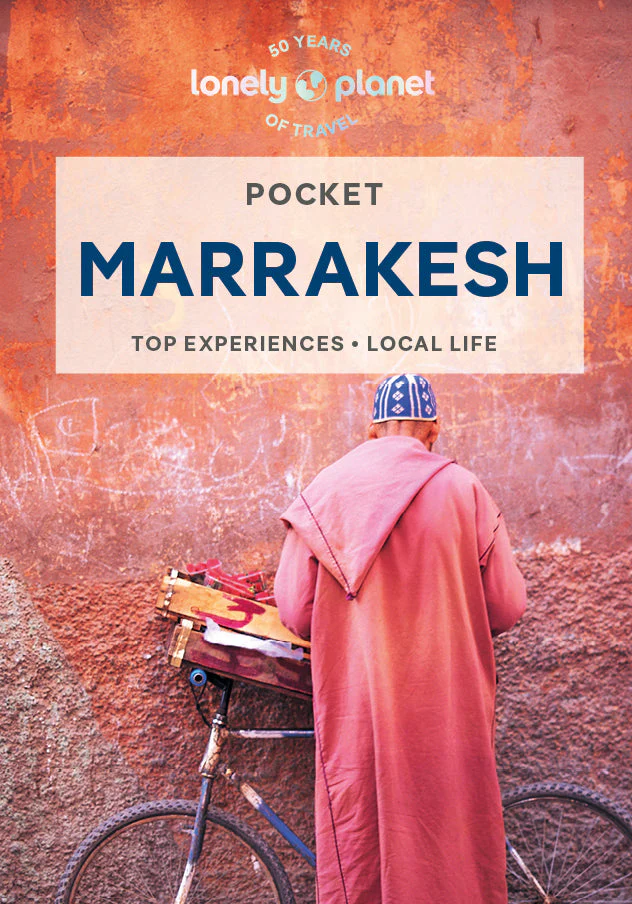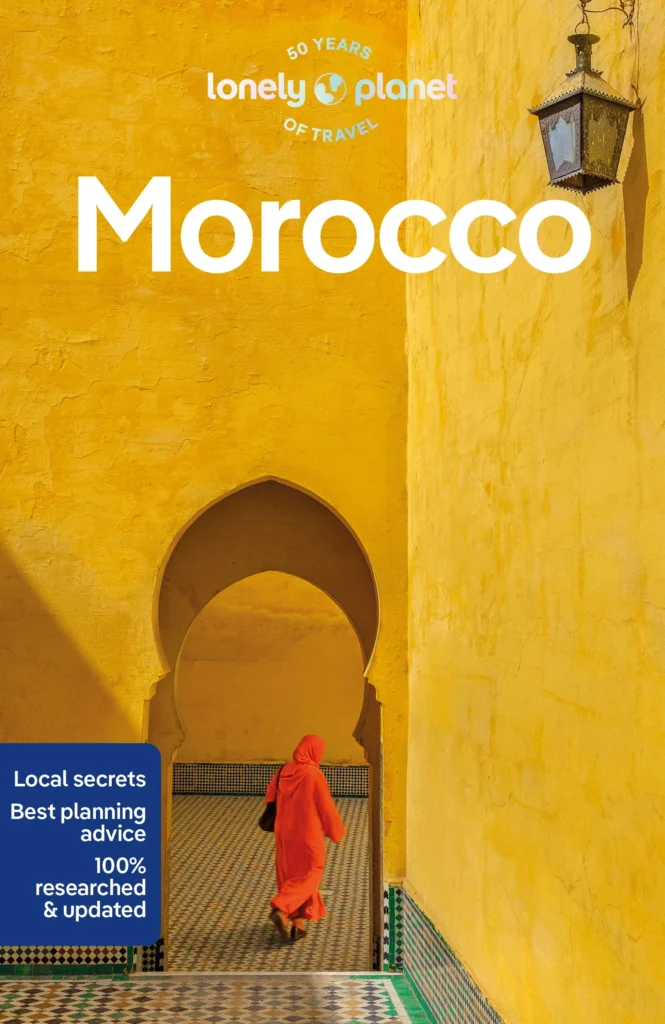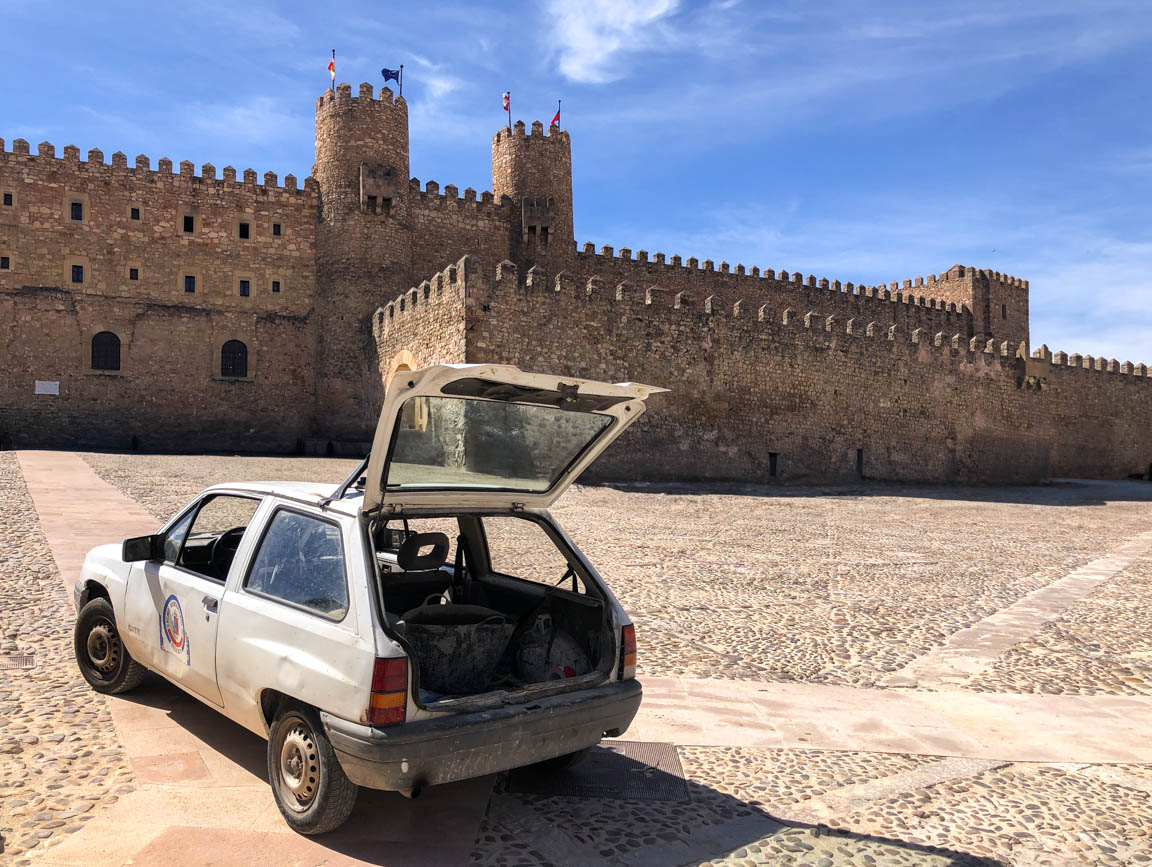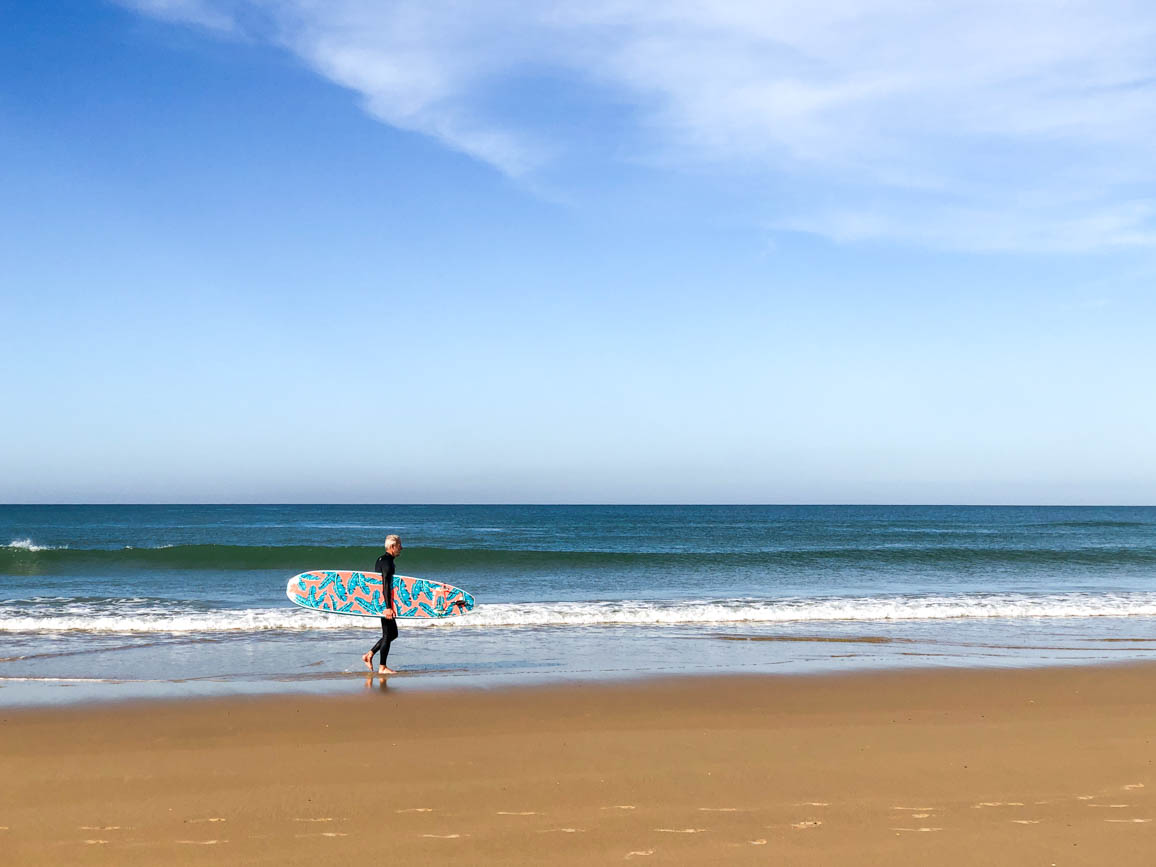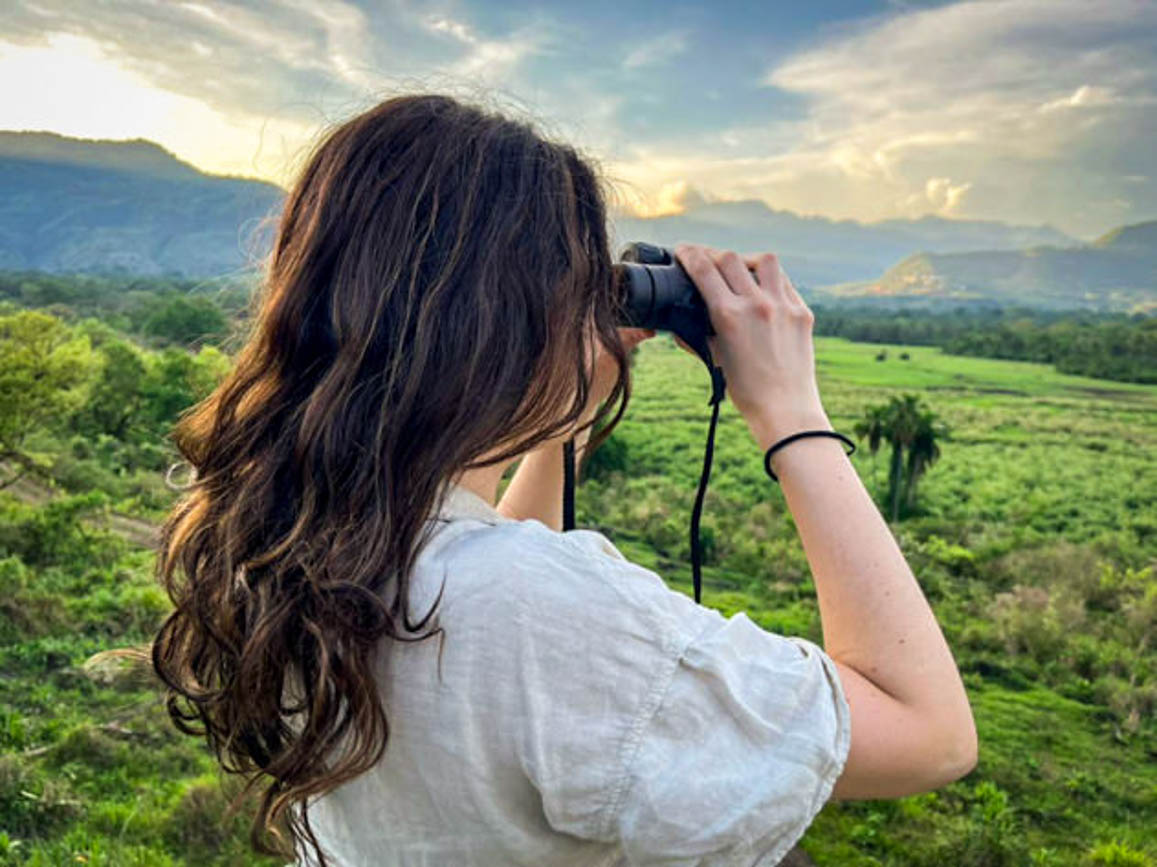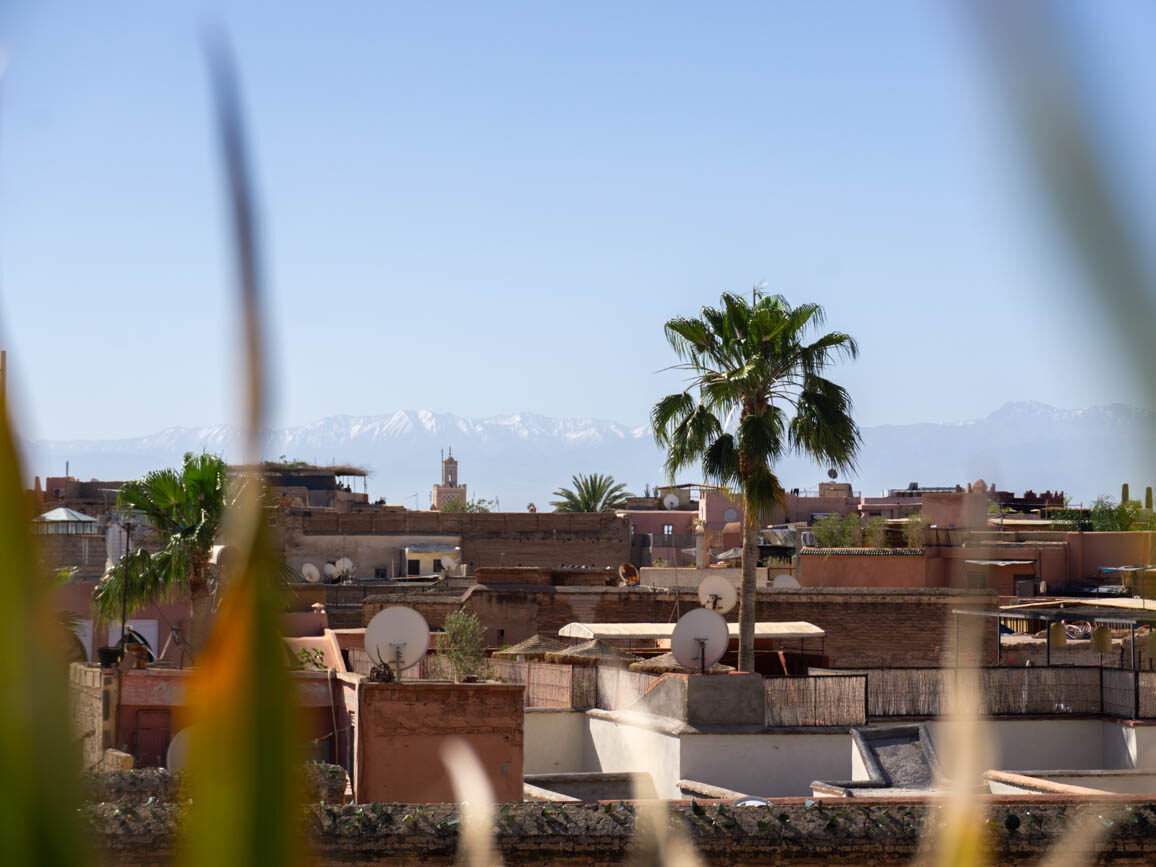
Things to do in Marrakech: travel guide + map
Located in the western part of the country, Marrakech is one of the top destinations to visit in Morocco. In this comprehensive travel guide, I’ll walk you through the best things to do in Marrakech, including where to eat and stay as well as some day trip ideas. At the end of this post, I’ve also included a map so you can easily pinpoint all the locations mentioned here.
***
Disclaimers:
- This post was originally written in December 2014 following my first road trip to the country with my Dad. It was updated in April 2025 to reflect the latest information available after my recent trip.to Marrakech, Agadir and Essaouira.
- Please note that this post includes some affiliate links. This means that, at no additional cost for you, I earn a commission if you make a purchase. In case you have any question about the companies advertised here or my status as an affiliate, please do not hesitate to contact me.
***
Throughout my trips to Marrakech, I used these couple of travel guidebooks by Lonely Planet to plan our stay and make the most out of it. I hope you’ll find them helpful too!
📸 Best things to do in Marrakech, Morocco
The city of Marrakech, also spelled as Marrakesh or مراكش in Arabic, is definitely one of the top destinations to visit in Morocco. And for a good reason. Rising in the shadow of the Atlas mountain range and enclosed within ochre-coloured walls, it is often referred as the Rose City or the Red City.
A former imperial city and one of the largest metropolis in the country after Casablanca, Rabat and Fez, Marrakesh has been the epicenter of culture and trade for ages. Nowadays, it attracts flocks of tourists every year thanks to its pleasant climate and intricate Moorish architecture.
In this section, I´ll take you through nine things to do in Marrakech, from bustling souks and serene gardens, to opulent palaces and architectural wonders. Please note that most of these attractions are located within the city walls of the Old Town of Marrakech, called the medina.
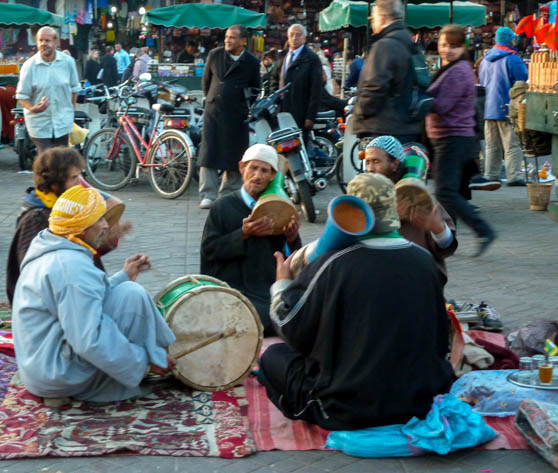
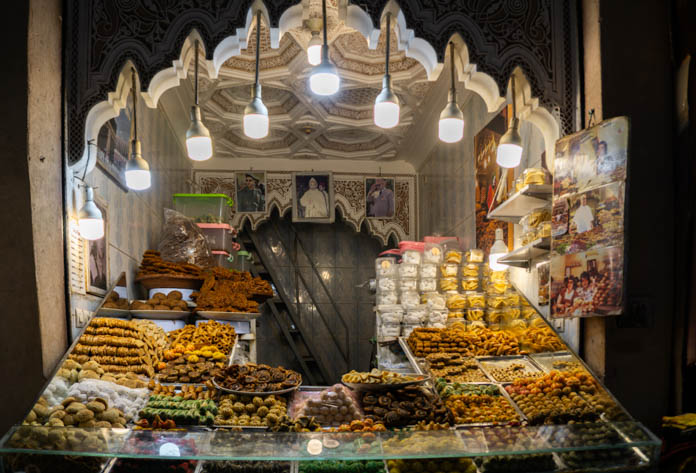
🧡 Place Jemaa El Fna
To kick off your visit to the Rose City, head to one of the top things to do in Marrakech: the vibrant square of Jemaa el-Fna. Lying at the entrance of the medina and encapsulating its dazzling energy and charm, it represents the heartbeat of Marrakech. It is even inscribed on the UNESCO list of Intangible Cultural Heritage of Humanity!
Unsurprisingly, all roads in the city seem to lead to Jemaa el-Fna. To fully appreciate its magic, visit at different times of the day, and if possible, also go to a rooftop to admire the panoramic views and soak in the ambiance. Early mornings offer a more tranquil glimpse into local life, while evenings unveil the square’s electrifying spirit.
You will find anything you can think of in the bustling Place Jemaa el-Fna, from snake charmers, fortune tellers with monkeys and traditional musicians, to fresh street vendors serving aromatic Moroccan delicacies in this open-air marketplace.
In sum, Jemaa el-Fna truly embodies the soul of Marrakech and is a must place to visit!
Watch out for ´tourist hunters´ in Jemaa El Fna square offering photo ops with monkeys or snakes!
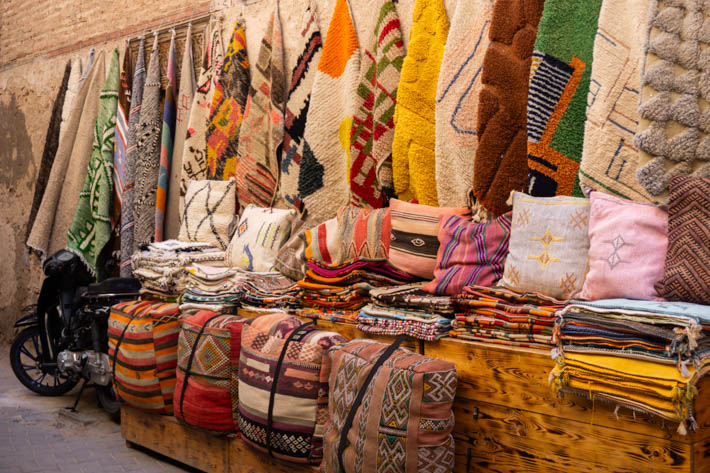
🛍 The Marrakech souks
If there´s a must-do activity you should experience when traveling to Marrakesh, that is shopping in a souk. Even if you´re not a big fan back home, I guarantee you this is a whole new ball game.
But first things first, what is a souk? This Arabic term refers to a market, typically outdoors. The souks (also spelled as souqs) are usually arranged according to the nature of the goods for sale and are known by the name of that product. Souks can be found throughout northern Africa, and they are a gathering place for locals to both shop and gossip. That´s why they´re so lively. 🙂
The souks of Marrakech are a shopper’s paradise in which you will find any kind of product you can think of, ranging from a silver teapot and a pair of Moorish slippers, to intricately woven rugs or exotic spices. These labyrinthine markets are brimming with treasures at every turn, and navigating them is not an easy task.
Coming from Fez, one thing that striked me when first visiting Marrakech was that the souks here were much more organized and opulent. You could tell many more international tourists travel to the Red City! That being said, haggling is culturally expected when shopping in a Moroccan souk, so head to my Morocco destination page for tips.
Here´s an alphabetical breakdown featuring some of Marrakech souks, even though the list is virtually endless. The ones mentioned here are located north and east of Jemaa El-Fna square.
- 🪙 Souk Addadine (metalwork)
- ✨ Souk Atarin (brass and copper items)
- 🧺 Souk Chouari (basket makers and wood turners)
- 🎨 Souk des Teinturiers (dyers souk)
- 🏺 Souk El-Bradiia (jugs)
- 👜 Souk El-Btana and Souk El-Kebir (leather goods)
- 🏮Souk Haddadine (lampshades, lanterns)
- 🪕 Souk Kimakhin (string instruments)
- 💎 Souk Siyyaghin (jewelry)
- 🥻Souk Semmarine (clothes)
- 👡 Souk Smata (belts and Moorish slippers)
- 🥓 Souk Zarbia (rugs)
In addition to all the abovementioned souks in the ancient medina, another couple of squares you might want to explore include Place des Épices (for baskets, hats and spices) and Place des Ferblantiers (selling mostly tinplates).
Haggling is a must when shopping in a souk—it’s part of the experience! Dive in with confidence and enjoy the friendly back and forth with the vendors.
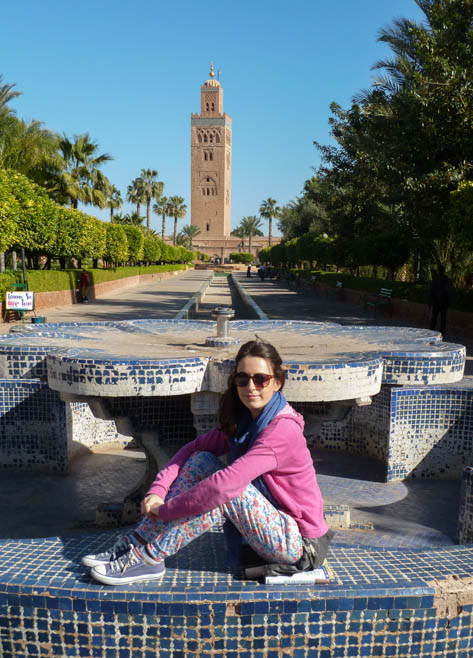
🕌 Koutoubia Mosque
The Koutoubia Mosque is one of the major attractions in the city of Marrakech. It was built around the year 1147 during the Almohad dynasty, near the manuscript souk that was once held around it (that´s why it translates as the booksellers’ mosque). Its two most characteristic elements are the minaret and the prayer hall.
On the one hand, the Moorish minaret measures more than 70 meters. Because of its imposing height, it is the highest point in the city and is easily visible from far away. Considered a symbol of Marrakech, it actually served as a model for the Giralda in Sevilla and the Hassan Tower in Rabat.
Refer to my section on travel tips for more details about visiting religious sites in Morocco.
On the other hand, the vast prayer hall can accommodate about 20.000 worshipers and is divided into sixteen galleries. However, note that, unless you´re a Muslim, you won´t be allowed inside.
The Koutoubia Mosque grounds are surrounded by beautiful gardens and locals riding horse-drawn carriages. Close by lies the iconic La Mamounia hotel.
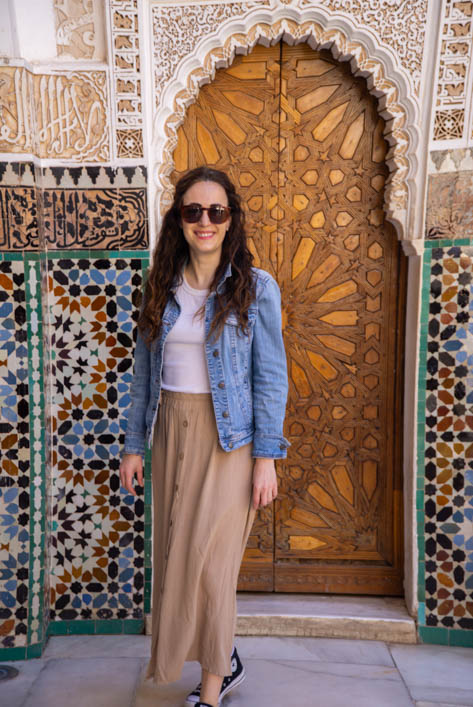
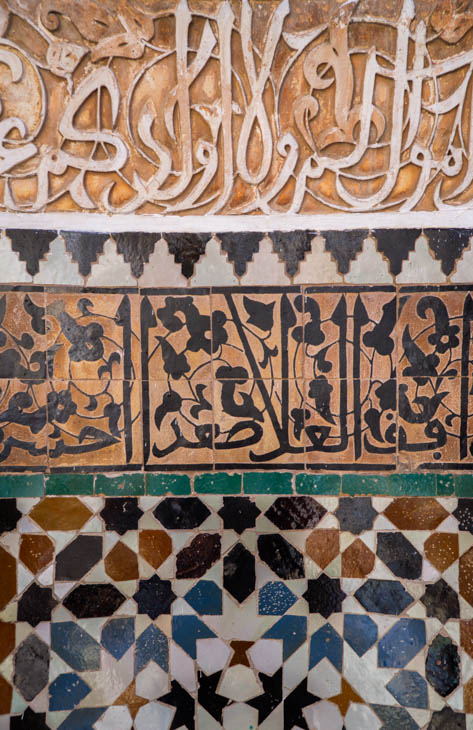
☪ Ben Youssef Madrasa
Madrasa (also spelled medersa) is the Arabic word for any type of educational institution, secular or religious (of any religion, not just Muslim).
Considered one of the largest madrasas of the Maghreb, the Ben Youssef Madrasa lies in the heart of the medina, close to the souks and to the nearby Ben Youssef Mosque.
This particular madrasa was founded in the middle of the 14th century and then rebuilt two centuries later. Architecturally speaking, it resembles the Bou Inania Madrasa in Fez because of its sumptuous decoration.
Back in the day, the Ben Youssef Madrasa welcomed up to 900 scholars, with their student rooms distributed over two floors around a magnificent courtyard.
Visiting this Koranic school during my most recent trip was a true highlight. Despite the many tourists, I loved admiring the details of this historic building, from the elaborate bronze entrance door, the zellij tiling (an artwork using geometric tiles that are set in a plaster base to form wonderfully intricate patterns that features prominently in Moroccan architecture), to the large prayer hall, the mihrab, the modest student rooms and the dome.
Both national and foreign visitors are welcome to explore this iconic religious landmark. Feel free to buy your tickets here.
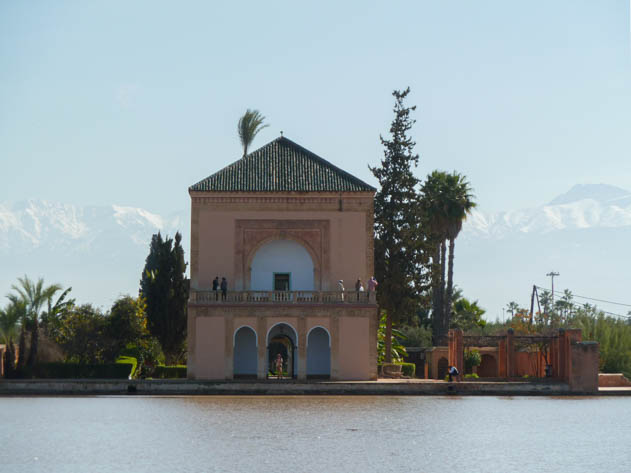
⛲ Menara
This emblematic place seems to have come out straight of a tale from the Thousand and One Nights. It was for sure one of my favorite things to do in Marrakech when I first visited the city.
Located at a certain distance from the medina, the Menara complex features two main elements: the Menara Gardens and the Menara Pavilion. If you´re visiting from the old town, you will likely run alongside a vast olive grove known as ´Oliveraie´.
On the one hand, the Menara Gardens are an area of almost 90 hectares surrounded by pastel walls, olive and fruit trees. In the 12th century, a large reflecting pool was dug in the centre of the garden to store water for the sultans. Note that accessing the Menara Garden is free, but you should purchase a ticket should you want to book a guided tour.
On the other hand, the Menara Pavilion was erected during the 19th century, when the garden was renovated. This building was used by the sultans in their love encounters. Legend has it that every morning, one of them would throw the concubine he had spent the previous night with into the pool!
Anyhow, the views from the Menara set against the backdrop of the Atlas Mountains are truly breathtaking.
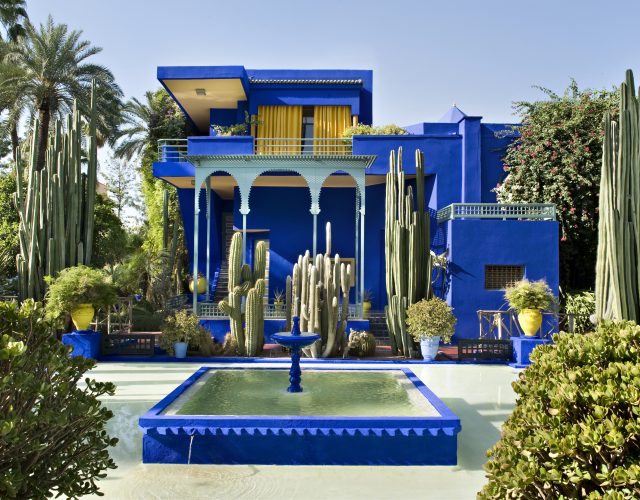
🌵 Jardin Majorelle
When visiting Marrakech, immerse yourself in the serenity of the Majorelle Garden. Located in the heart of the Ville Nouvelle, this villa was first built by French painter Jacques Majorelle in 1923. It was later owned by the famous designer Yves Saint Laurent and his partner Pierre Bergé.
Compared to the bustling city outside, Jardin Majorelle is an oasis of calm with its vibrant cobalt-blue walls, exotic plants, and tranquil fountains.
Nowadays, this complex is made up of five distinct elements:
- Boutique: souvenir shop featuring the best of traditional Moroccan craftmanship.
- Café Majorelle: take a bite or have a drink at this cafeteria after visiting Majorelle Garden.
- Jardin Majorelle: this garden is one of the city’s most iconic landmarks. Among others, in it you will find tropical flowers, more than 400 varieties of palm trees, over 1.800 species of cactus, and a pond with floating water lilies.
- Musée Pierre Bergé des Arts Berbères: inaugurated in 2011, the museum displays more than 600 pieces of Berber art collected by Yves Saint Laurent and his partner Pierre Bergé over the years.
- Musée Yves Saint Laurent Marrakech: this museum is devoted to the work of the legendary French designer.
Buy your tickets well in advance and arrive early in the morning to beat the crowds.
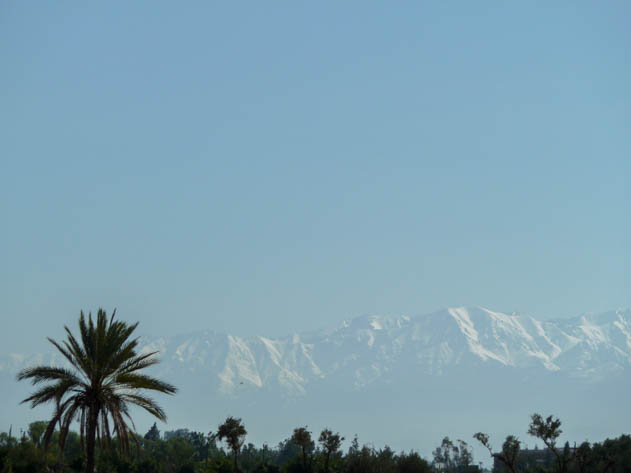
🌴 La Palmeraie
Located on the road to Casablanca just 22 km north of Marrakech, this vast palm oasis features various hundred thousand palm trees, covering an area of 54 square miles. The palm grove is made up of fields, gardens and orchards irrigated by pools and wells, with breathtaking views of the Atlas mountains. Unfortunately, it is progressively losing its agricultural function due to urban development.
You can discover La Palmeraie by car or horse-drawn carriage, although the more adventurous travelers would prefer riding a camel or a quad.
🔵 Bahia Palace
Bahia Palace (or Palais de la Bahia in French) is a stunning 19th-century palace complex with intricate tilework and lush gardens.
Literally meaning the marvelous or the brilliant, the name ´Bahia´ probably refers to the favorite wife of Ba Ahmed, Grand Vizier and sponsor of the palace. The best craftmen worked on the construction and opulent decoration of the Bahia Palace.
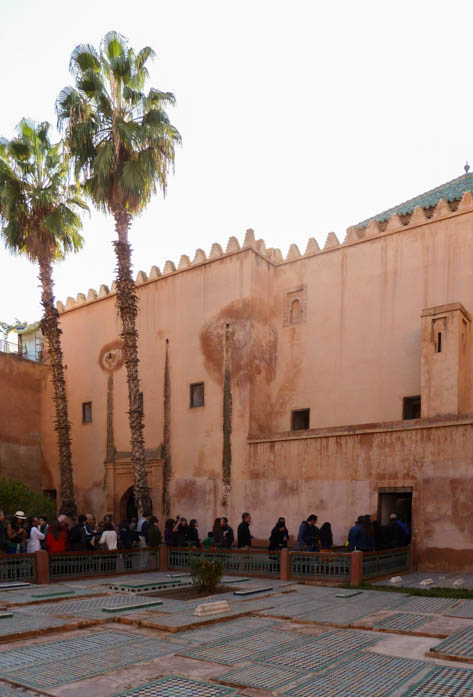
🪦 Saadian tombs
Last but not least on our list of the best things to do in Marrakech, the tombs of the Saadian dynasty are one of the most refined examples of Moroccan Islamic architecture. This royal necropolis dates from the end of the 16th century to the 18th century, although it remained closed to the public until 1917.
The Saadian Tombs are made up of two mausoleums located in a flower-planted garden. The central mausoleum is dedicated to Ahmed el Mansur (1578-1603), and includes three funerary wings reminiscent of the rawda (cemetery) in Granada. The most spectacular of those wings is the Room of the Three Niches, which houses the ornate tombs of young princes. The second mausoleum is a green-roofed building of more modest proportions.
Steps away from the Saadian Tombs lies the Moulay al-Yazid Mosque, also known as the Kasbah Mosque. As a matter of fact, the ´kasbah´ was the former citadel of Marrakech located in the southern part of the medina.
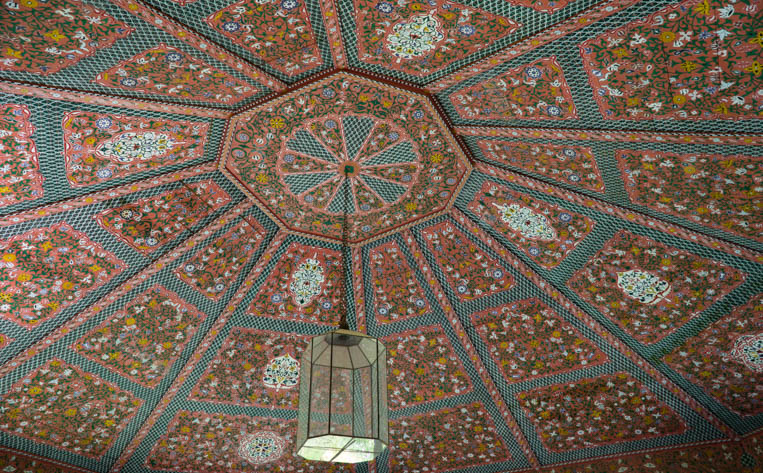
🇲🇦 Other things to do in Marrakesh
In addition to the best things to do in Marrakech listed above, it´s also worth exploring other places off the beaten track. Below you will find a few ideas sorted by category, from gardens and museums, to palaces and religious buildings.
- 🏬 Explore other districts: within the city walls of the ancient medina you will find the bustling souks, the kasbah (the former citadel) and the mellah (the Jewish quarter, which includes a synagogue and the Miara cemetery). But it´s worth venturing to the outskirts of the medina too. Head to the Ville Nouvelle (or new town) to wander around Guéliz (famous for its art déco architecture) and Hivernage (housing many hotels, chic restaurants and shops).
- 🌸 Gardens, fountains and parks: in addition to the famous Jardin Majorelle and the Menara Gardens listed earlier among the best things to do in Marrakech, check out these other verdant spots in the city (Anima Garden, Jardin Alwaha, Jardins d´Agdal, Jardin des Arts, Le Jardin Secret -peaceful space, although I found it overpriced compared to other attractions much worth it such as the Ben Youssef Madrasa-, Parc El Harti or Parc Lalla Hasna next to the Koutoubia). A fountain worth mentioning is Chrob ou Chouf, a historic wall fountain dating from the late 16th century near the Ben Youssef Madrasa.
- 🇲🇦 Get a ´henna´ tattoo: often associated with weddings, festivals, and special occasions, the intricate henna designs symbolize joy, luck, and protection. Experience this cherished Moroccan tradition in Jemaa el-Fna square or in the souks. In fact, I took the opportunity to get a henna tattoo on my hand when I first visited Marrakech. It was a great way to take home a souvenir that would last a few days.
- 🧭 Imposing Moorish gates and ramparts: since its founding, Marrakech has had a system of solid defensive walls that were expanded by successive dynasties, from the Almoravids and Almohads to the Saadians. These well-preserved defenses surrounded the medina, protecting its palaces and gardens. The city walls are currently 19 km long. Some of the monumental gates (bab) throughout the city walls are exceptional examples of Arabic architecture. A few examples worth mentioning include Bab Agnaou, Bab Aylan, Bab Debbagh, Bab Doukkala, Bab El Jedid, Bab El Khemis, Bab Ghmat or Bab Er Robb.
- 🖼 Museums: the city of Marrakech hosts a variety of interesting museums, including among others Dar Bellarj, the House of Photography (Maison de la Photographie), Moroccan Culinary Arts Museum (it offers cooking classes!), Musée Dar El Bacha, Musée Dar Si Said (carpets and weaving), Musée de la Musique Mouassine (music museum), Musée de Marrakech (Moroccan heritage), Musée du Parfum, Museum of African Contemporary Art Al Maaden (MACAAL), Tiskiwin Museum – Bert Flint, or the Water Museum.
- ✨ Palaces: as a former imperial city, Marrakech housed endless palaces. In addition to the abovementioned Bahia Palace, others worth featuring here include Dar El-Makhzen (still used as a royal residence nowadays) and El Badi Palace (erected in the 16th century, but now largely in ruins).
- 🧖♀️ Relax at a ´hammam´: no visit to Marrakech is complete without experiencing a hammam, a traditional Moroccan bathhouse. This cleansing ritual combines steam, exfoliation, and massage, leaving you relaxed and rejuvenated. Marrakech’s public bathing houses are also where locals ritually gather and trade gossip. A few top hammam recommendations in Marrakech include Les Bains de Marrakech, Riad Tarabel or Royal Mansour.
- ☪ Religious buildings: besides the Koutoubia Mosque or the Ben Youssef Madrasa that I referred to earlier, there are other remarkable places of worship in Marrakech. Some of these include imposing mosques (Bab Doukkala Mosque, Ben Youssef Mosque, El Mouassine Mosque or Kasbah Mosque) and zawiyas (in the Islamic world, these are religious buildings and institutions particularly associated with Sufism; some great examples in the city are Zawiya Sidi Bel Abbas or Zawiya Sidi Ben Slimane El Jazouli) as well as a domed tomb built during the Almoravid dynasty (Koubba Ba´Adyin). You will also find a church and various synagogues.
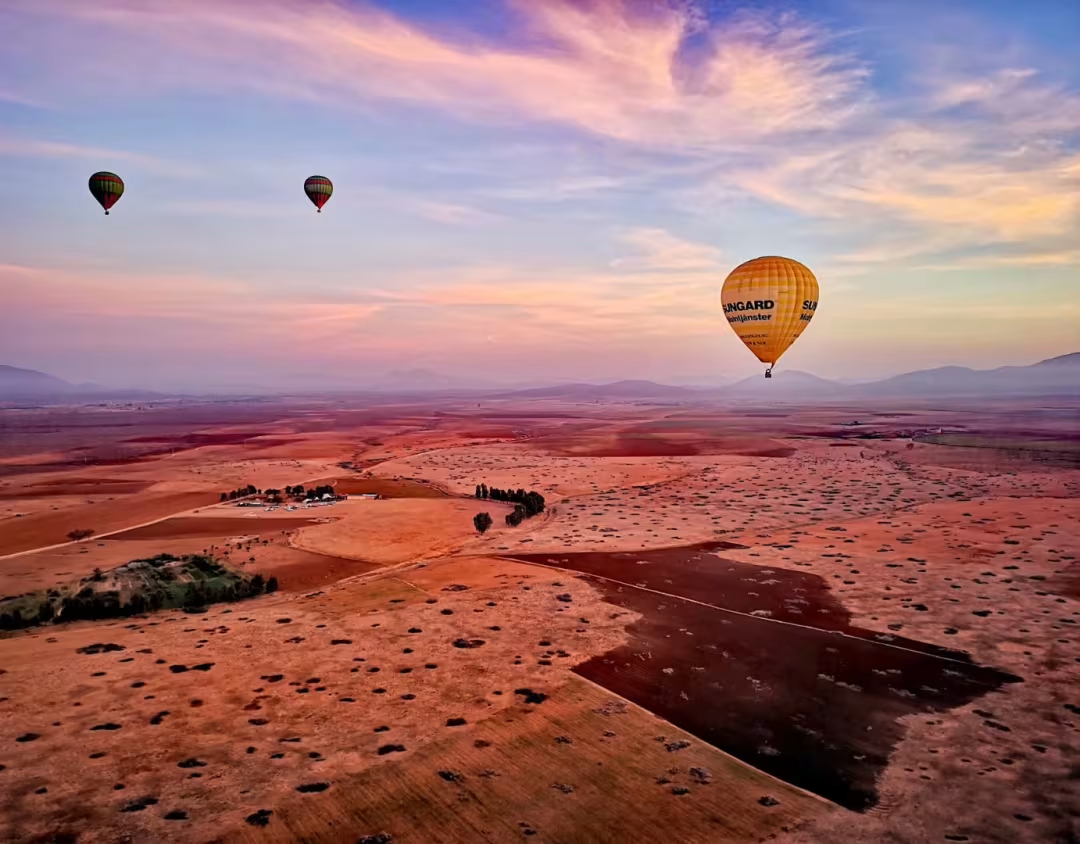
Feeling adventurous? Check out these outdoor activities with Manawa in Marrakech.
Camel ride at sunset in the Agafay desert, near Marrakech
Hot-air balloon flight in Marrakech, Morocco
Quad Biking Excursion in Agafay Desert, Marrakech
Survival Course in Morocco departing from Marrakech
📝 Travel tips: Marrakech weather, suggested itinerary and more
In case this is your very first time visiting the Moroccan city of Marrakesh, here are a few tips to help you navigate this fascinating destination. For further details about useful words in Arabic, as well as recommendations on cultural norms, haggling or safety, head to my Morocco destination page.
- ☀ Best time to visit: the best seasons to visit Marrakech are spring (March to May, perfect for blooming gardens) or fall (September to November, which brings cooler evenings great for wandering) when the weather is pleasantly warm, making it ideal for exploring the city’s vibrant attractions. I´ve traveled to the city in both April and December, and I can confirm that spring is definitely nicer as evenings in the winter can be chilly.
- 💰 Currency: whenever I travel abroad to a country that doesn´t use euros as was the case for Morocco, I like to have my Revolut Card and app handy to convert money and then pay in local currency. It´s easy, efficient and helps you avoid commissions while you´re on the go. Should you want to exchange money in town, Hotel Ali near Place Jemaa El Fna was the place recommended to us; this is where we changed our euros into dirhams.
- ⏳ Historic background: since its founding in the 11th century by the Almoravids, Marrakech has passed through dynasties (the Almohads, the Saadians and the Alawites), becoming an imperial capital and a cultural crossroads. The city was also influenced by French rule during the Protectorate of Morocco (1912-1956), a period during which Marshal Lyautey played a key role in shaping the city’s modern infrastructure while preserving its rich cultural heritage. The country officially gained independence on 2 March 1956. In sum, each period has left its mark, shaping its unique identity.
- 📍Itinerary: I would suggest that you spend at least two nights in town, if not more, to soak up the energy of the city. This should give you sufficient time to explore some of the best things to do in Marrakech.
- 🗓 Key events: if you´re visiting Marrakesh soon, mark your calendars for the Rose Festival in nearby El Kelaa M’Gouna in May, or the Marrakech International Film Festival in November.
- 📸 Photography: if you want to capture the magical light of the Rose City of Marrakech, make sure to wander the streets around golden hour, be it early in the morning or before sunset. The city walls are particularly photogenic because of their interesting shapes and their warm ochre colour!
- 🛟 Safety: when visiting Marrakesh, especially the bustling medina and crowded squares like Jemaa El-Fma, be mindful of your belongings and stay alert. Note that there is even a special police (Police Touristique) patroling the main touristic sites. In my opinion, traveling as a woman to Marrakech is generally safe, but it’s important to take precautions to ensure a comfortable experience. Dressing modestly can help you avoid unwanted attention, especially in traditional areas, and sticking to busy, well-lit streets is advisable when exploring at night. Be confident but polite when declining persistent vendors or unsolicited advances. Traveling with a companion or group is ideal, but solo travel is also manageable with preparation and awareness. Trust your instincts, respect local customs, and enjoy the warm hospitality Morocco is known for. For extra peace of mind when traveling abroad, you can calculate how much you would pay for your health insurance with the SafetyWing widget below. During my recent 1-week trip to Morocco, I purchased my travel insurance through Safety Wing for $14.07. It only took me a few minutes to buy it and what I loved is that you could even generate an insurance card and visa letter to keep them handy at all times.
🍽 Where to eat in Marrakech: best places to savor Moroccan food
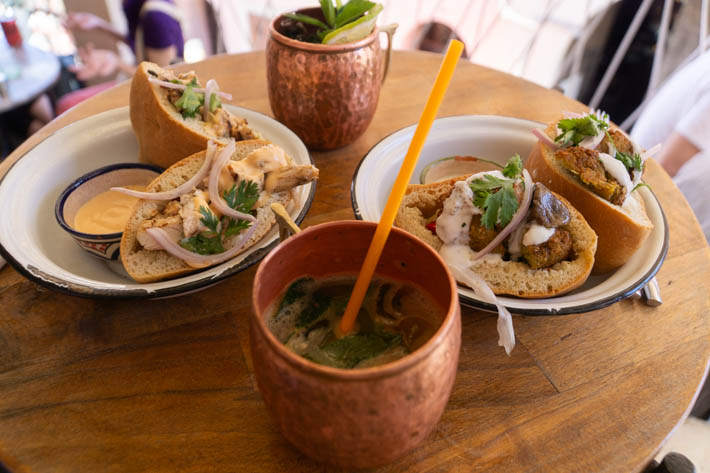
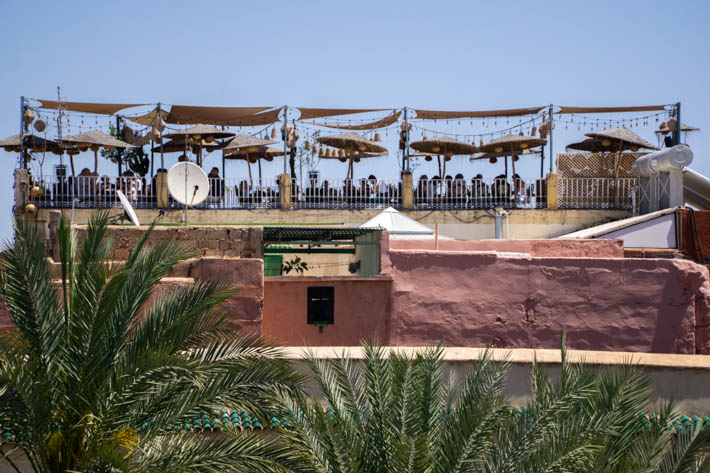
Although some dishes of Moroccan cuisine have their origins in the Berber indigenous people, Moroccan food in general owes much to the influence of neighboring territories. Some traditional Moroccan dishes include couscous, harira or tagine. Check out my section on Moroccan food for more details.
The city of Marrakech is literally a culinary haven, offering a variety of dining experiences to suit every taste and budget. From the bustling food stalls of Jemaa el-Fna square to elegant upscale restaurants and trendy bistrots, the city serves as a gateway to authentic Moroccan cuisine.
Eating Moroccan food is one of my favorite experiences when visiting the country. I love the mix of sweet and salty in the traditional cuisine.
Below you will find my own selection of places to savor the best of Moroccan food in Marrakech, sorted by category. The ones marked in dark red in the map below are the places I tried myself during my visit.
- 🍵 Cafeterias: Bacha Coffee, Café des Épices, Café du Livre (also a bookstore), Café Les Négociants, Grand Café de la Poste, Pâtisserie des Princes.
- 🍊 Markets and street food: during our first visit to Marrakech, my Dad and I truly embraced the Moroccan street food culture. The best spot is, you guessed it, the bustling Jemaa El-Fna square, which turns into a gigantic open-air restaurant at sunset, offering delicious meat skewers or fresh juices. During our stay, we bought freshly squeezed grapefuit juice and an assortment of nuts from the food stalls there. We also got grilled sardines and some olives from a street stall near Bab Agnaou. Other places you can try for street food include the endless souks throughout the city or Place du 16 Novembre, where a daily market takes place.
- 🍽 Restaurants (most of them offer Moroccan food): Al Fassia (two locations in Aguedal and Guéliz), Bazaar Café, Cafe Babouche, Comptoir Darna (they also have live music, belly dancing shows and a club), Dar Marjana, Dar Moha (they offer cooking classes too), Dar Yacout, Folk Marrakech, La Ferme (this riad and boutique spa also hosts a lush garden with a restaurant; we had a selection of Moroccan salads along with a delicious couple of vegetable tagine and chicken tagine), La Maison Arabe, La Table du Marché, La Trattoria (Italian cuisine), Le Jardin, Le Tobsil, Les Jardins du Lotus, Nomad (we had a lovely dinner on the terrace and the atmosphere was very cool even though it was windy, thank goodness they had blankets!; we ordered a delicious lentil salad followed by fish tagine, chicken pastilla and green tea), restaurants at La Mamounia Hotel, Terrasse Bakchich, Yazel (we found this incredible spot serving Levantine food steps away from Le Jardin Secret; we had a quick lunch at the charming terrace consisting of a falafel sandwich, a chicken sandwich and two mocktails; the food was mouthwatering, especially the chicken, so definitely coming back!).
- 🍹 Rooftop bars, cafes and restaurants: Atay Cafe (lovely place where we had a delicious chicken and lemon tagine, with mixed skewers and Moroccan pastries), BlackChich, Brasserie R (in Guéliz), Café Arabe, Dardar, La Table de La Kasbah, La Table du Souk (located in La Sultana Hotel), Le Foundouk, Le Grand Balcon du Café Glacier, Le Salama (this one and the latter both overlook Place Jemaa El-Fna), Le Trou au Mur, L´mida, Kabana, Maison Ka, Naranj (Lebanese cuisine).
Do you like my content? Subscribe to my newsletter to stay tuned.
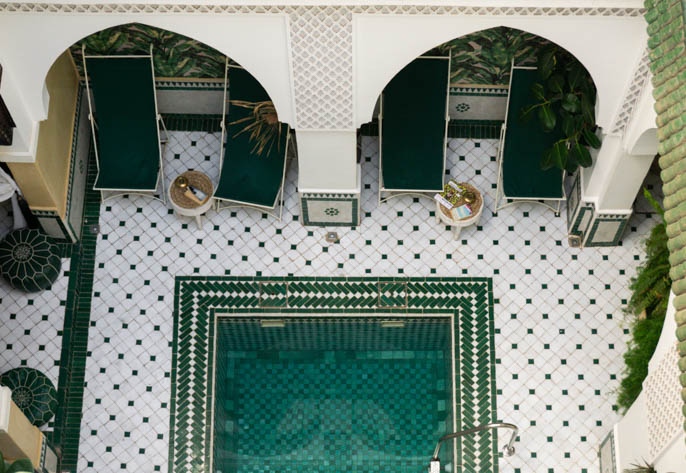
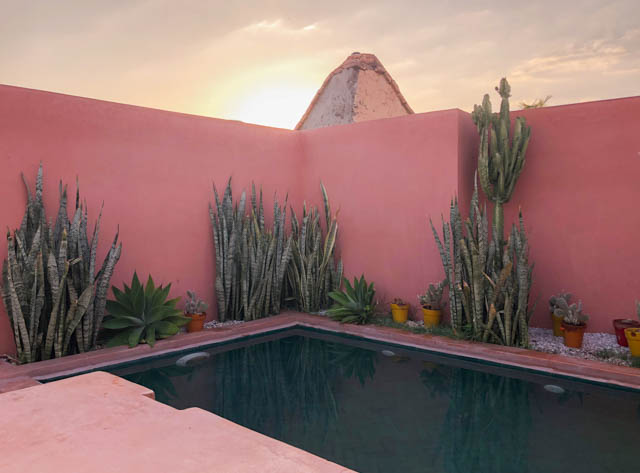
🛏 Where to stay: best Marrakech hotels
Ever since traveling to Morocco for the first time, I fell in love with the riads. These traditional Moroccan houses or palaces are built around a patio and often feature an indoor garden, offering a tranquil retreat. Bonus point if they also have a swimming pool :). In my view, it´s way more authentic and charming to stay in a riad than in a standard hotel when you´re visiting the country. It certainly adds to the travel experience!
Listed below you will find a variety of accommodations to stay in Marrakech, from traditional riads to hotels, sorted by category. For your ease of reference, they are marked in grey in the map. The places where I´ve stayed are highlighted in dark grey.
- Riads in Marrakech: Riad Amani (this is where we stayed during my first visit in December 2014; reasonable walking distance to the main attractions in the medina), Riad AnaYela, Riad BE, Riad Botanica, Riad Dar Dada, Riad El Ouarda, Riad Dar En-Nawat, Riad Hayati, Riad Kaiss, Riad Magie, Riad Sakkan, Riad Sassa Finda (decent riad where we spent the last night of our most recent trip), Riad Tarabel, Riad Tililaila (charming riad with a beautiful terrace in the heart of the medina, close to the Madrasa Ben Youssef), Riad Tresor, Riad Yasmine, Riad 72.
- Luxury hotels in Marrakech (⭐⭐⭐⭐⭐): Amanjena, Dar Ayniwen, Es Saadi, Four Seasons Resort, Hivernage Hôtel & Spa, Hôtel Dar Les Cigognes, Izza, Jnane Tamsna, La Maison Arabe, La Mamounia (this iconic hotel near the Koutoubia mosque is an attraction in itself; even if you´re not staying there, you´re welcome to wander its gardens, orchards, restaurants and swimming pool. They even have a casino indoors!), La Sultana, Le Méridien N´Fis, Les Jardins de la Medina, Peacock Pavilions, Pickalbatros Hôtel du Golf Palmeraie, Royal Mansour, Sofitel Marrakech, Villa des Orangers.
- Medium range hotels in Marrakech (⭐⭐⭐ or ⭐⭐⭐⭐): Bab Hôtel, Dar Asdika, El Fenn, Hotel Ali, Hôtel Octogone Terre, Les Deux Tours.
- Budget accommodation in Marrakech (⭐⭐ or below): Hôtel Gallia, Manzil La Tortue, Moroccan House, Peekaboo Hostel, The Central House.
For more accommodation options in Marrakech, feel free to check out Airbnb, Booking or Hostelworld, my go-to platforms wherever I travel.
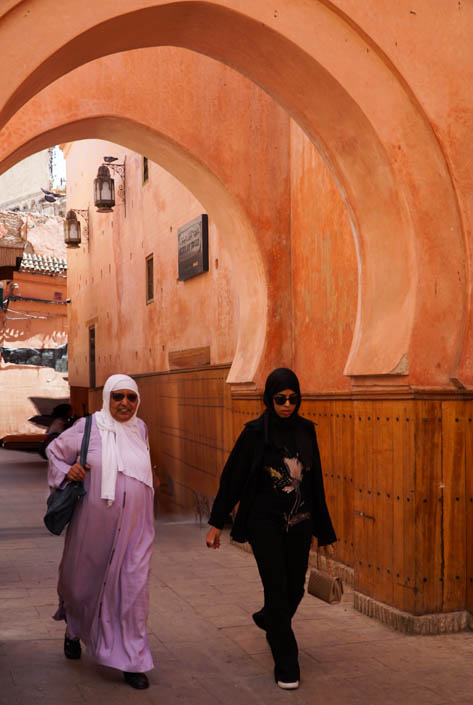
👣 How to get around Marrakesh
The city of Marrakech has two distinct parts. On the one hand lies the walled medina (Old Town), where you will find the bustling souks, the kasbah (the former citadel) and the mellah (the Jewish quarter). On the other hand is the Ville Nouvelle (new Town), built during the French Protectorate and encompassing modern districts such as Guéliz or Hivernage.
To avoid getting completely lost when navigating the densely packed medina and its mazelike alleys, especially at night, try to identify reference points. The minarets of the mosques are extremely useful in this case, with the Koutoubia Mosque lying west and the Ben Youssef Mosque lying north. Another good idea is to download your itinerary on Google Maps in advance, so you can use it without wifi connection.
Below I´ve listed the different ways in which you can get around Marrakech:
- 🚌 By bus: we actually traveled from Marrakech to Agadir with CTM, and then from Essaouira back to Marrakech with Supratours. Both were great experiences,especially compared to my first visit to the country renting a car with my father. However, note that each company has its own bus station, which is why we got to a different location to the one we had departed from in the first place. I know it sounds confusing, but that´s just the way it works!
- 🚙 By car: you may rent a car to drive in and out of Marrakech in case you´re on a road trip (as was our case the first time I visited), but in my opinion, you don´t need one to get around the city since you can easily walk, take a ´petit taxi´ or hire a horse-drawn carriage. Besides, trust me, driving in Morocco can be wild! In case you do have a car, note that parking is not an easy task. Furthermore, you may find locals asking you to pay them to ´watch´ your vehicle while you´re away.
- 👣 By foot: this is the only way to explore the souks and the bustling medina given that vehicles can´t even make it into the narrow alleys.
- 🐎 By horse-drawn carriage: as in some Spanish cities (take Málaga, Palma de Mallorca or Sevilla, for example), you can book a ride to explore Marrakech with a local. Most horse-drawn carriages can be found in Guéliz, along the Mohammed V Avenue, or in Place Jemaa El Fna. That being said, it is always a good idea to agree on the price before starting your tour of the city.
- ✈️ By plane: the Marrakech – Menara airport (RAK) lies just 6 km southwest of the city center. From there, you can take bus no. 19 to the city centre for 30 Dh. The city is well connected to destinations around the world. To give you an idea, the couple of times I´ve visited Marrakech I flew to and from Barcelona and Bilbao.
- 🚕 By taxi: a very cheap means of transport is the iconic, yellow taxi known as ´petit taxi´. You can hail one in Guéliz or in Jemaa el Fna square, but as with the horse-drawn carriage rides, make sure to agree on the price in advance. Should you feel safer when arriving at the Marrakech airport, you can book a taxi at an outside booth or do so online, and then provide the details of your accommodation. The rates start at 100 Dh (vs. 30 Dh one-way with bus no. 19).
- 🚂 By train: head to the train station (gare de Marrakech) if you´re connecting by train to other Moroccan destinations such as Casablanca, Rabat or Settat.
Consider looking into the Marracashcard to explore the city of Marrakech while you take advantage of discounts in more than 100 locations.
📍 Map with the best things to do in the city of Marrakech
For your ease of reference, below you will find a Marrakech map with all the spots mentioned throughout this blog post, including the main attractions, hotels, restaurants or day trip destinations. Use it to plan your next trip!
🧳 Day trips from Marrakesh
The Red City has a lot of attractions to discover. But it´s also worth exploring some nearby destinations should you want to escape the buzz. Here are a few suggested day trips from Marrakech:
- Agafay Desert: experience a dreamy sunrise hot air balloon ride over the desert, an exciting camel ride, or a luxurious dinner in a tent (haima) under the stars.
- Ait Ben Haddou: a UNESCO World Heritage Site famous for its role in films like Gladiator. Make sure to wander around the ksar, a group of earthen buildings surrounded by high walls, an example of the traditional architecture of southern Morocco.
- El Kelaa M’Gouna: make sure to visit this spot near Marrakesh during the annual three-day Rose Festival that takes place in mid-May. Located in an area known as the Valley of Roses, you can expect lots of entertainment, from local dance and music shows to a display of a vast array of rose products from the distilleries.
- High Atlas mountains: perfect for hiking and exploring Berber villages such as Imlil. Note that Mount Toubkal is Morocco’s highest peak at 4,167 metres.
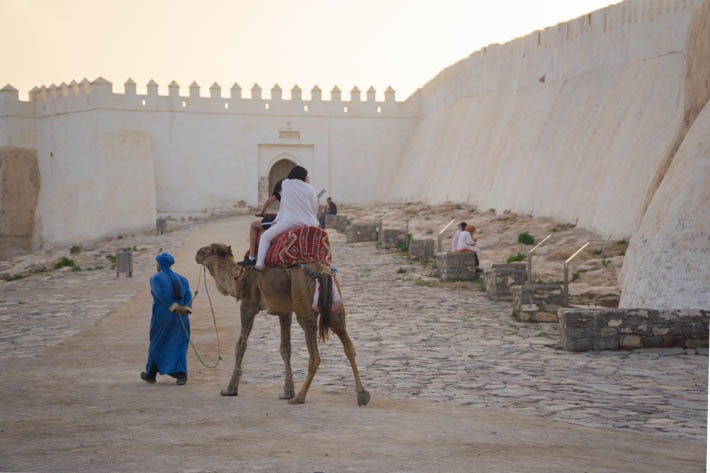
Browse my Morocco resources for further inspiration!
Casablanca (updated travel guide coming up soon)
Six Moroccan cities you should visit (coming up soon)
Fez (updated travel guide coming up soon)
Rabat (updated travel guide coming up soon)
Last but not least, feel free to explore these destinations throughout Africa and the Middle East.
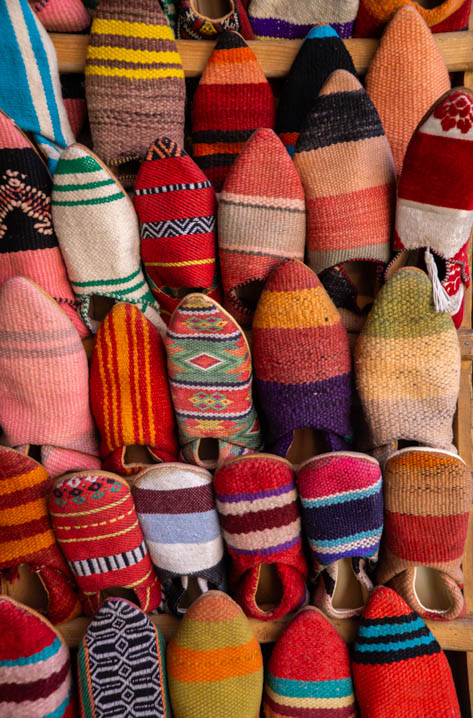
🎒 My final thoughts on the Moroccan city of Marrakech
All in all, Marrakech is a city that will awaken your senses and capture your heart, where tradition meets modernity, offering travelers an unforgettable adventure filled with colors, sounds, and aromas. From the chaotic charm of Jemaa el-Fna to the serene beauty of the Menara Gardens, there’s truly something for everyone.
I hope that you enjoyed this comprehensive travel guide detailing the best things to do in Marrakech. Feel free to leave your questions and comments below, or show your support by loving this article!
***
✈️ Curious to know where I’ll be traveling next? ✈️
Stay tuned by following me on social media (Facebook, Instagram, X) and subscribe to my newsletter for regular updates!
In the meantime, safe travels around the world!
***
| GET READY FOR YOUR NEXT TRIP! |
|---|
| Browse my travel resources page to plan your upcoming trip. |
| Feeling adventurous? Book any outdoor activities worldwide with Manawa! |
| Get medical or health insurance via SafetyWing for extra peace of mind. |
| Looking for sports equipment? Feel free to browse my Decathlon profile for inspiration. |
| Use the comprehensive and helpful Anaya Touring or Lonely Planet travel guidebooks to plan your trip. |
| Book memorable activities and tours around the world with Get Your Guide. |
| Use your Revolut Card to pay in local currency when you’re traveling abroad! |

